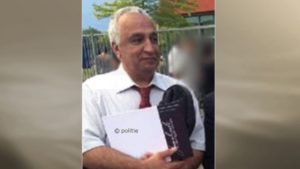June 22, 2018

An Iranian expatriate shot to death more than two years ago in the Netherlands has now been identified as the man who planted the bomb resulting in the most deadly terrorist attack in Iran—the killing of 72 leaders of the Islamic Republic in 1981.
Among the dead then was Ayatollah Mohammad Hossaini-Beheshti, the head of the Judiciary and widely viewed as the second most powerful figure in the Islamic Republic. Ali-Akbar Hashemi-Rafsanjani, who left the meeting moments before the bomb went off, later rose to that ranking.
The expatriate who was gunned down outside his home in Almere near Amsterdam in December 2015 was known as Ali Motamed. He was 56 years old at the time of his death. He was an electrician. But his widow has now told Dutch police that he was actually Mohammad-Reza Kolahi-Samadi, the man Iran identified decades ago as the bomber. He was sentenced to death in absentia.
The widow said her husband told her his real identity only after they were married.
He was shot to death as he left his house by two men who drove off immediately after the shooting. But local security cameras photographed the getaway vehicle.
Just a few weeks ago, in March, police said they arrested two suspects. The police did not name them but said they were petty criminals in Amsterdam. The supposition is that they were hired by the Islamic Republic to carry out a contract killing and put distance between Iran and the assassination.
Iran traditionally used Lebanese Shiites to carry out most of its murders abroad. But a few killings in the 1990s were exposed and tracked to Iranians, which appears to have prompted Iran to halt its assassination program.
The BBC reported that security cameras showed a dark blue BMW making three trips to Motamed’s address. On the first occasion, Motamed left home later than usual and the killers had given up waiting. The second time, police said the attackers did not go through with the killing because a neighbor came out of his house at the same time as Motamed.
It was on their third visit that the men, dressed head-to-toe in black, opened fire and left. The getaway car was later found burned out nearby.
Phone records show that on each occasion the attackers made the journey from Amsterdam to lie in wait.
It was Motamed’s widow who told police that her husband was concealing a secret past, according to Paul Vugts, a local reporter who has tracked the case.
Vugts said Motamed acknowledged being the killer in 2000, when Iranian media circulated old pictures of him.
“He always told his son he would tell him the whole story once the son became 18, but that never happened,” Vugts told the BBC. “The most logical [explanation] is that the secret service of Iran caught up with him.”
The reporter used his underworld contacts to try to join up the dots. “The weird thing is, the ones accused of shooting [Mot-amed] are just regular Amster-dam guys from the streets.” He said they were involved in the Dutch drug business.
The chairman of the local conservative liberal party (VVD), Ulysse Ellian, has asked the Dutch government to investigate the theory that Ali Motamed was actually Mohammad Reza Kolahi-Samadi and the victim of an Iranian state-sponsored assassination.
Ellian is of Iranian descent. His father opposed the regime and fled Iran when Ellian was 15 years old.
“I fear it will be difficult to prove who he was, but what I want to know is what are we going to tell all the people who witnessed this assassination in their neighborhood and we have no answer. Neither the Netherlands nor Iran are confirming his identity. Maybe we will never know,” Ellian told the BBC.
A spokesman for the Dutch prosecution service told the BBC: “We have two men in custody who are suspected of being involved in the death. The investigation has not led to any signs of involvement by Iranian authorities.”
In the meantime, police have offered a 10,000-euro ($11,600) reward to anyone who can “complete the puzzle,” a sign that this murder mystery is far from solved.


















